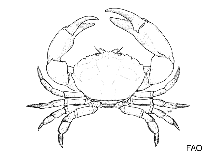Eriphia smithii MacLeay, 1838
Rough redeyed crab
Upload your photos
Google image | No image available for this species;
drawing shows typical species in Eriphiidae.
Google image | No image available for this species;
drawing shows typical species in Eriphiidae.
Classification / Names आम नाम | उपशब्द | CoL | ITIS | WoRMS
Malacostraca | Decapoda | Eriphiidae
Environment: milieu / climate zone / गहराई सीमा / distribution range पारिस्थितिकी
प्रवाल-भित्ति संयुक्त; गहराई सीमा 1 - ? m (संदर्भ 102564). Tropical
Distribution देश | ऐफ ऐ ओ क्षेत्र | Ecosystems | संयोग | भूमिका
Indo-Pacific.
Length at first maturity / आकार / Weight / Age
परिपक्व अवधि: Lm ? range ? - ? cm Max length : 6.0 cm CL पुल्लिंग / अलिंग; (संदर्भ 343)
Short description आकृति विज्ञान
Carapace rectangular, anterior surface granulated; anterolateral margins with numerous spines, but without distinct teeth or lobes. Base of movable finger of larger claw with large molariform tooth. Color: dark reddish brown overall, with bright red eyes.
Inhabits reefs. Subtropical and tropical climates (Ref. 343). Found on cliff holes and crevices. Active at both diurnal and nocturnal low tides, foraging from the rocky and soft substrates. Exhibits algal grazing during the day and predation, specifically at night, on crustaceans and mollusks (Ref. 76500). Largely an opportunistic feeder (Ref. 102732). Inhabits shallow waters, in reefs and rocky substrates. Takes shelter in crevices and holes (Ref. 9773).
Life cycle and mating behavior परिपक्व अवधि | पुनरुत्पत्ति | मछलीऔ का अंडे देना | Eggs | Fecundity | Larvae
Members of the order Decapoda are mostly gonochoric. Mating behavior: Precopulatory courtship ritual is common (through olfactory and tactile cues); usually indirect sperm transfer.
Main reference
संदर्भ | संयोजक | सहयोगीयो
Ng, P.K.L. 1998. (संदर्भ 343)
IUCN Red List Status
(संदर्भ 130435: Version 2024-2)
CITES status (संदर्भ 108899)
Not Evaluated
CMS (संदर्भ 116361)
Not Evaluated
Threat to humans
Human uses
| FishSource |
साधन
अधिक जानकारी
Trophic Ecology
पारिस्थितिकी
Population dynamics
बाढ़
Max. ages / sizes
Length-weight rel.
Length-length rel.
Length-frequencies
Mass conversion
भर्ती
बहुतायत
Max. ages / sizes
Length-weight rel.
Length-length rel.
Length-frequencies
Mass conversion
भर्ती
बहुतायत
Life cycle
Distribution
इंटरनेट स्रोत
BHL | BOLD Systems | CISTI | DiscoverLife | FAO(Publication : search) | Fishipedia | GenBank (genome, nucleotide) | GloBI | Gomexsi | Google Books | Google Scholar | Google | PubMed | Tree of Life | Wikipedia (Go, खोज) | Zoological Record
Estimates based on models
Price category
(संदर्भ 80766):
Unknown.



